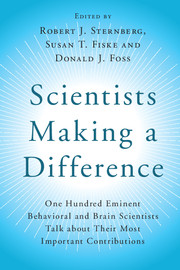 Scientists Making a Difference
Scientists Making a Difference Book contents
- Frontmatter
- Contents
- List of Contributors
- Foreword: Making a Creative Difference = Person × Environment
- Preface
- Part I Introduction
- Part II Biological Bases of Psychology: Genes, Brain, and Beyond
- Part III Cognition: Getting Information from the World and Dealing with It
- Part IV Development: How We Change Over Time
- Section A Cognitive Development
- 40 Building a Unique Network of Scientific Enterprises
- 41 Research on Children's Recollections: What a Difference a Phone Call Made
- 42 Development of Children's Knowledge About the Mind
- 43 Real Representations in Two Dimensions
- 44 Language and the Social Brain: The Power of Surprise in Science
- 45 The Importance of Developmental Plasticity
- 46 Levels of Analysis in Cognitive Aging
- 47 The Longitudinal Study of Adult Cognitive Development
- 48 How Does Change Occur?
- 49 Cognitive Abilities of Infants
- Section B Social/Personality Development
- Part V Motivation and Emotion: How We Feel and What We Do
- Part VI Social and Personality Processes: Who We Are and How We Interact
- Part VII Clinical and Health Psychology: Making Lives Better
- Part VIII Conclusion
- Afterword: Doing Psychology 24×7 and Why It Matters
- Index
- References
46 - Levels of Analysis in Cognitive Aging
from Section A - Cognitive Development
Published online by Cambridge University Press: 05 August 2016
- Frontmatter
- Contents
- List of Contributors
- Foreword: Making a Creative Difference = Person × Environment
- Preface
- Part I Introduction
- Part II Biological Bases of Psychology: Genes, Brain, and Beyond
- Part III Cognition: Getting Information from the World and Dealing with It
- Part IV Development: How We Change Over Time
- Section A Cognitive Development
- 40 Building a Unique Network of Scientific Enterprises
- 41 Research on Children's Recollections: What a Difference a Phone Call Made
- 42 Development of Children's Knowledge About the Mind
- 43 Real Representations in Two Dimensions
- 44 Language and the Social Brain: The Power of Surprise in Science
- 45 The Importance of Developmental Plasticity
- 46 Levels of Analysis in Cognitive Aging
- 47 The Longitudinal Study of Adult Cognitive Development
- 48 How Does Change Occur?
- 49 Cognitive Abilities of Infants
- Section B Social/Personality Development
- Part V Motivation and Emotion: How We Feel and What We Do
- Part VI Social and Personality Processes: Who We Are and How We Interact
- Part VII Clinical and Health Psychology: Making Lives Better
- Part VIII Conclusion
- Afterword: Doing Psychology 24×7 and Why It Matters
- Index
- References
Summary
Much of my professional life has been devoted to studying the relations between aging and cognition in order to understand why increased age is associated with lower levels of performance on different types of cognitive tests. This phenomenon of age-related cognitive decline is clearly evident in comparisons from standardized tests used to assess cognitive ability in adults, and significant negative age relations are typically found in tests as diverse as the assembly of blocks to match a design and the selection of items that best complete a sequence.
I began my career as a graduate student at the University of Michigan in the early 1970s, where my focus was on information-processing perspectives on cognition in normal (i.e., college student) adults. This approach to cognition emphasized the decomposition of cognitive tasks into sequences of processing operations, with the theoretical speculations often expressed in flow charts of the type used in computer programming. When I started studying relations between aging and cognition, I assumed that the information-processing perspective would be valuable in “localizing the loss” or “isolating the impairment” associated with aging to a few critical processing stages. Indeed, the dominant interpretations of adult age differences in cognition in the 1970s and 1980s emphasized task-specific explanations, such as ineffective strategy use or deficits in a critical component such as encoding or abstraction. However, as I read the relevant literature, I discovered that many different types of cognitive measures were negatively related to age, and not merely a few as one might expect if the age differences were caused by a discrete deficit in a specific cognitive process such as memory retrieval. In other words, adults in their sixties and seventies not only performed at lower levels than adults in their twenties and thirties on tests of memory, but also on tests of reasoning, spatial visualization, problem solving, etc. Although it was clearly possible that age differences in different cognitive variables had specific causes that were largely independent of one another, I began investigating an alternative interpretation that a small number of relatively broad and general factors might be contributing to the age differences across a wide variety of cognitive tasks.
My initial focus was on measures obtained from reaction-time and speeded paper-and-pencil tasks because they were postulated to represent how quickly simple cognitive operations could be performed.
- Type
- Chapter
- Information
- Scientists Making a DifferenceOne Hundred Eminent Behavioral and Brain Scientists Talk about Their Most Important Contributions, pp. 214 - 217Publisher: Cambridge University PressPrint publication year: 2016
